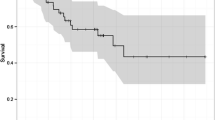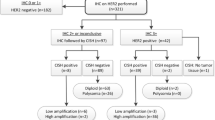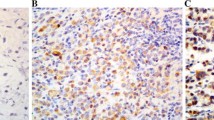Abstract
The primary aim was to determine whether Epo-R immunohistochemical expression is related to disease free survival (DFS) in specimens of GC from patients who underwent adjuvant chemoradiation. Specimens of gastric adenocarcinomas obtained from 44 patients who had undergone curative gastrectomy and adjuvant treatment were investigated immunohistochemically expression of Epo-R. Three patterns for Epo-R staining were defined: Pattern A (secretory cells-like staining), Pattern B (parietal-like staining) and Pattern C (chief-like staining). Median DFS was 38 months (CI 95%: 33–43) and 15 months (IC 95%: 3–27) in the pattern B and C, respectively, but it was not reached in the pattern A (p = 0.06). Our findings suggest that there may be a relationship between Epo-R expression and DFS in the patients with GC resected.




Similar content being viewed by others
References
Tilbrook PA, Klinken SP (1999) Erythropoeitin and erythropoeitin receptor. Growth Factors 17:25–35
Ebert BL, Bunn HF (1999) Regulation of the erythropoeitin gene. Blood 94:1864–77
Wojchowski DM, Gregory RC, Miller CP, Pandit AK, Pircher TJ (1999) Signal transduction in the erythropoeitin receptor system. Exp Cell Res 253:143–156
Masuda S, Okano M, Yamagishi K, Nagao M, Ueda M, Sasaki R (1994) A novel site of erythropoeitin production. Oxygen-dependent production in cultured rat astrocytes. J Biol Chem 269:19488–19493
Acs G, Acs P, Beckwith SM (2001) Erythropoeitin and erythropoetin receptor in breast carcinoma. Cancer Res 61:3561–3565
Pallard C, Gouileux F, Charon M, Groner B, Gisselbrecht S, Dusanter-Fourt I (1995) Interleukin-3, eryhropoeitin and prolactin activate a STAT5-like factor in lymphoid cells. J Biol Chem 270:15942–15945
Carroll MP, Spivak JL, McMahon M, Weich N, Rapp UR, May WS (1991) Erythropoeitin induces Raf-1 activation and Raf-1 is required for erythropoetin-mediated proliferation. J Biol Chem 266:14964–14969
Acs G, Zhang PJ, McGarth CM (2003) Hypoxia-inducible erythropoietin signalling in squamous dysplasia and squamous cell carcinoma of the uterine cervix and its potential role in cervical carcinogenesis and tumour progression. Am J Pathol 162:1789–1806
Mohyeldin A, Lu H, Dalgard C, Stephen Y, Noam C, Acs G, Verma A (2005) Erythropoetin signaling promotes invasiveness of human head and neck squamous cell carcinoma. Neoplasia 7:537–543
Henke M, Laszig R, Rube C, Schafer U, Haase KD, Schilcher B, Mose S, Beer KT, Burger U, Dougerty C (2003) Erythropoetin to treat head and neck cancer patients with anemia undergoing radiotherapy: randomized, double blind, placebo controlled trial. Lancet 362:1255–1260
MacDonald J, Smalley S, Benedetti J, Hundahl S, Estes N, Stemmermann G, Haller D, Ajani J, Gunderson L, Jessup M, Materson J (2001) Chemoradiotherapy after surgery compared with surgery alone for adenocarcinoma of the stomach or gastroesophageal junction. N Eng J Med 345:725–730
Lauren P (1965) The two histological main types of gastric carcinoma. Diffuse and so-called intestinal type carcinoma. Acta Pathol 64:31–40
Carneiro F, Seixas M, Sobrinho-Simoes M (1987) New elements for an update classification of the carcinoma of the stomach. Pathol Res Pract 182:308–325
Japanese Research Society of Gastric Cancer (1995) Japanese classification of gastric cancer. Tokio: Kanehara & company 8:199–201
Kim MJ, Bogic L, Cheung CY, Brace RA (2001) Placental expression of erithropoetin mRNA protein and receptor in sheep. Placenta 22:484–489
Siren AL, Knerlich F, Poser W, Gleiter CH, Bruck W, Ehrenreich H (2001) Erythropoetin receptor in human ischemic/hypoxic brain. Acta Neuropathol 101:271–276
Hanby AM (2005) The pathology of breast cancer and the role of the histopathology laboratory. Clin Oncol (R Coll Radiol) 17:234–239
Barrett C, Magee H, O'toole D, Daly S, Jeffers M (2006) Amplification of the HER-2 gene in breast cancers testing 2+ weak positive by HercepTestTM immunohistochemistry: false positive or false negative IHC? J Clin Pathol 250:15–19
Nakamura E, Sugihara H, Bamba M, Hattori T (2005) Dynamic alteration of the E-cadherin/catenin complex during cell differentiation and invasion of undifferentiated-type gastric carcinomas. J Pathol 349:58–61
Ribatti D, Marzullo A, Nico E, Crivellato E, Ria R (2003) Erythropoeitin as an angiogenic factor in gastric carcinoma. Histopathology 42:246–50
Okada A, Kinoshita Y, Maekawa T (1996) Erytropoeitin stimulates proliferation of rat cultured gastric mucosal cells. Digestion 57:328–332
Shao Y, Yang SB, Wang MW, Wu BY, You WD, Li H (2004) Gene expression profile of human adenocarcinoma by cDNA microarray and clustering. Zhonghua Yi Xue Yi Chuan Xue Za Zhi 21:110−115
Lugli A, Spichtin H, Maurer R, Mirlacher M, Kiefer J, Huusko P, Azorsa D, Terracciano L, Sauter G, Kallioniemi OP, Mousses S, Tornillo L (2005) Erb-B2 expression across 138 human tumor types in a tissue microarray: high levels of expression in gastrointestinal cancers. Clin Cancer Res 11:6450–6458
Gomes LI, Esteves GH, Carvalho AF, Cristo EB, Hirata R Jr, Martins WK, Marques SM, Camargo LP, Brentani H, Pelosof A, Zitron C, Sallum RA, Montagnini A, Soares FA, Neves EJ, Reis LF (2005) Expression profile of malignant and nonmalignant lesions of esophagus and stomach: differential activity of functional modules related to inflammation and lipid metabolism. Cancer Res 65:7127–7136
Chen J, Rocken C, Klein-Hitpass L, Gotze T, Leodolter A, Malfertheiner P, Ebert MP (2004) Microarray analysis of gene expression in metastatic gastric cancer cells after incubation with the methylation inhibitor 5-aza-2'-deoxycytidine. Clin Exp Metastasis 21:389–397
Leung SY, Yuen ST, Chu KM, Mathy JA, Li R, Chan AS, Law S, Wong J, Chen X, So S (2004) Expression profiling identifies chemokine (C-C motif) ligand 18 as an independent prognostic indicator in gastric cancer. Gastroenterology 127:457–469
Tay ST, Leong SH, Yu K, Aggarwal A, Tan SY, Lee CH, Wong K, Visvanathan J, Lim D, Wong WK, Soo KC, Kon OL, Tan P (2003) A combined comparative genomic hybridization and expression microarray analysis of gastric cancer reveals novel molecular subtypes. Cancer Res 63:3309–3316
Chen X, Leung SY, Yuen ST, Chu KM, Ji J, Li R, Chan AS, Law S, Troyanskaya OG, Wong J, So S, Botstein D, Brown PO (2003) Variation in gene expression patterns in human gastric cancers. Mol Biol Cell 14:3208–3215
Takeshita A, Shinjo K, Naito K, Ohnishi K, Higuchi M, Ohno R (2002) Erythropoietin receptor in myelodysplastic syndrome and leukemia. Leuk Lymphoma 43:261–264
Selzer E, Wacheck V, Kodyium R, Schlagbauer-Wadi H, Schlegel W, Pehamberger H, Jansen B (2000) Erythropoeitin receptor expression in human melanoma cells. Melanoma Res 10:421–426
Belda Iniesta C, De Castro Carpeño J, Casado Saenz E, Feliu Batlle J, Bernabeu F, Alves J, Cejas P, Sereno M, Perona R, Gonzalez Baron M (2006) Erythropoietin receptor expression in bladder cancer. ASCO 2006 Annual Meeting Proceedings (Post-Meeting Edition) 24:4584
Eccles TG, Patel A, Verma A, Nicholson D, Lukes Y, Tuttle RM, Francis GL (2003) Erythropoietin and the erythropoietin receptor are expressed by papillary thyroid carcinoma from children and adolescents. Expression of erythropoietin receptor might be a favorable prognostic indicator. Ann Clin Lab Sci 33:411–422
Takeshita A, Shinjo K, Higuchi M, Miyawaki S, Takemoto Y, Kishimoto Y, Saito K, Takuchi H, Kuriyama K, Kimura Y, Asou N, Takahashi M, Hotta T, Kanamaru A, Ueda R, Ohno R (2003) Quantitative expression of erythropoietin receptor (EPO-R) on acute leukaemia cells: relationships between the amount of EPO-R and CD phenotypes, in vitro proliferative response, the amount of other cytokine receptors and clinical prognosis. Japan Adult Leukaemia Study Group. Br J Haematol 108:55–63
Acs G, Chen M, Xu X, Acs P, Verma A, Koch CJ (2004) Autocrine erythropoietin signaling inhibits hypoxia-induced apoptosis in human breast carcinoma cells. Cancer Lett 214:243–251
Hirst DG (1991) What is the importance (???) of anemia in radiotherapy? The value of animal studies. Radiother Oncol 20:29–33
Harrisson LB, Chadha M, Hill RJ, Hu K, Sasha D (2002) Impact of hypoxia and anemia on radiation therapy outcomes. Oncologist 7:492–508
Varlotto J, Stevenson MA (2005) Anemia, tumor hypoxemia, and the cancer patient. Int J Radiat Oncol Biol Phys 63:25–36
Winter SC, Shah KA, Campo L, Turley H, Leek R, Corbridge RJ, Cox GJ, Harris A (2005) Relation of erythropoietin and erythropoietin receptor expression to hypoxia and anemia in head and neck squamous cell carcinoma. Clin Cancer Res 11:7614–7620
Hardee ME, Arcasoy MO, Blackwell KL, Kirkpatrick JP, Dewhirst MW (2006) Erythropoietin biology in cancer. Clin Cancer Res 12:332–9
Yasuda Y, Masuda S, Chikuma M, Inoue K, Nagao M, Sasaki R (1998) Estrogen-dependent production of erytrhopoetin in uterus and its implication in uterine angiogenesis. J Biol Chem 273:25381–25387
Elliott S, Busse L, Bass MB, Lu H, Sarosi I, Sinclair AM, Spahr C, Um M, Van G, Begley CG (2006) Anti-Epo receptor antibodies do not predict Epo receptor expression. Blood 107:1892–1895
Author information
Authors and Affiliations
Corresponding author
Rights and permissions
About this article
Cite this article
Sereno, M., De castro, J., Belda-Iniesta, C. et al. EPO-R Expression Patterns in Resected Gastric Adenocarcinoma Followed by Adjuvant Chemoradiation Treatment. Pathol. Oncol. Res. 15, 1–10 (2009). https://doi.org/10.1007/s12253-008-9118-9
Received:
Accepted:
Published:
Issue Date:
DOI: https://doi.org/10.1007/s12253-008-9118-9




